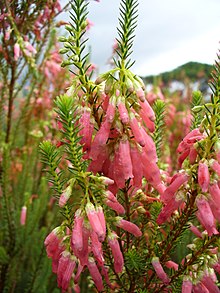Erica mammosa: Difference between revisions
Darorcilmir (talk | contribs) No edit summary |
Tom.Reding (talk | contribs) m WP:TREE cleanup++ and/or WP:GenFixes |
||
| (14 intermediate revisions by 10 users not shown) | |||
| Line 1: | Line 1: | ||
{{Short description|Species of flowering plant}} |
|||
{{Taxobox |
|||
{{Cleanup bare URLs|date=August 2022}} |
|||
{{Speciesbox |
|||
|image = Erica mammosa flower.jpg |
|image = Erica mammosa flower.jpg |
||
| ⚫ | |||
|regnum = [[Plantae]] |
|||
| ⚫ | |||
|unranked_divisio = [[Angiosperms]] |
|||
| ⚫ | |||
|unranked_classis = [[Eudicots]] |
|||
|unranked_ordo = [[Asterids]] |
|||
|ordo = [[Ericales]] |
|||
|familia = [[Ericaceae]] |
|||
| ⚫ | |||
| ⚫ | |||
|binomial = ''Erica mammosa'' |
|||
| ⚫ | |||
| url= http://www.theplantlist.org/tpl1.1/record/kew-2793782 |
| url= http://www.theplantlist.org/tpl1.1/record/kew-2793782 |
||
| title= Erica mammosa | publisher= The Plant List | |
| title= Erica mammosa | publisher= The Plant List |access-date=17 February 2018}}</ref> |
||
}} |
}} |
||
'''''Erica mammosa''''' |
'''''Erica mammosa''''', the '''nine-pin heath''', is a [[species]] of [[flowering plant]] in the family [[Ericaceae]], that is naturally restricted to the southwestern corner of the [[Western Cape]], [[South Africa]]. |
||
It is a shrub, growing to {{convert| |
It is a shrub, growing to {{convert|2.5|m|ft|abbr=off|frac=2}} tall and broad, that produces masses of flowers in a range of colours from light-pink to orange to bright red. |
||
The species name '' |
The species name ''mammosa'' means "with breasts" and refers to the udder-like tubular shape of the flowers.<ref name=RHSLG>{{cite book |last=Harrison |first=Lorraine |title=RHS Latin for Gardeners |year=2012 |publisher=Mitchell Beazley |location=United Kingdom |isbn=978-1845337315 }}</ref> |
||
This plant is |
This plant is found as an ornamental garden subject.<ref>http://www.plantzafrica.com/plantefg/ericamammosa.htm</ref> |
||
In the [[United Kingdom|UK]] it has gained the [[Royal Horticultural Society]] |
In the [[United Kingdom|UK]] it has gained the [[Royal Horticultural Society]]'s [[Award of Garden Merit]].<ref name = RHSPF>{{cite web | url= https://www.rhs.org.uk/Plants/23556/i-Erica-mammosa-i/Details |
||
| title = RHS Plantfinder - ''Erica mammosa'' |
| title = RHS Plantfinder - ''Erica mammosa'' |
||
| |
| access-date=17 February 2018}}</ref><ref>{{cite web | url= https://www.rhs.org.uk/plants/pdfs/agm-lists/agm-ornamentals.pdf | title = AGM Plants - Ornamental | date = July 2017 | page = 36 | publisher = Royal Horticultural Society |
||
| access-date = 16 February 2018}}</ref> Like many heathers it is a [[calcifuge]], meaning that it must be grown in an acidic soil. It requires a sunny, sheltered spot with sharp drainage. It tolerates low temperatures down to {{convert| 0|C|F|abbr=on}}, but will not stand freezing.<ref name = RHSPF /> |
|||
| accessdate = 16 February 2018}}</ref> |
|||
==Gallery== |
==Gallery== |
||
| Line 32: | Line 27: | ||
File:Erica mammosa flower Koeberg.JPG |
File:Erica mammosa flower Koeberg.JPG |
||
</gallery> |
</gallery> |
||
| ⚫ | |||
==See also== |
|||
* [[Cape Flats Sand Fynbos]] |
|||
* [[Kenilworth Racecourse Conservation Area]] |
|||
* [[Biodiversity of Cape Town]] |
|||
==References== |
==References== |
||
| ⚫ | |||
{{Reflist}} |
{{Reflist}} |
||
{{Taxonbar|from=Q5387946}} |
|||
[[Category:Erica|mammosa]] |
[[Category:Erica|mammosa]] |
||
[[Category:Endemic flora of |
[[Category:Endemic flora of the Cape Provinces]] |
||
[[Category:Flora of the Cape Provinces]] |
|||
[[Category:Fynbos]] |
[[Category:Fynbos]] |
||
[[Category:Taxa named by Carl Linnaeus]] |
|||
Latest revision as of 20:17, 12 January 2024
| Erica mammosa | |
|---|---|

| |
| Scientific classification | |
| Kingdom: | Plantae |
| Clade: | Tracheophytes |
| Clade: | Angiosperms |
| Clade: | Eudicots |
| Clade: | Asterids |
| Order: | Ericales |
| Family: | Ericaceae |
| Genus: | Erica |
| Species: | E. mammosa
|
| Binomial name | |
| Erica mammosa | |
Erica mammosa, the nine-pin heath, is a species of flowering plant in the family Ericaceae, that is naturally restricted to the southwestern corner of the Western Cape, South Africa.
It is a shrub, growing to 2.5 metres (8 feet) tall and broad, that produces masses of flowers in a range of colours from light-pink to orange to bright red.
The species name mammosa means "with breasts" and refers to the udder-like tubular shape of the flowers.[2]
This plant is found as an ornamental garden subject.[3] In the UK it has gained the Royal Horticultural Society's Award of Garden Merit.[4][5] Like many heathers it is a calcifuge, meaning that it must be grown in an acidic soil. It requires a sunny, sheltered spot with sharp drainage. It tolerates low temperatures down to 0 °C (32 °F), but will not stand freezing.[4]
Gallery[edit]
References[edit]
- ^ "Erica mammosa". The Plant List. Retrieved 17 February 2018.
- ^ Harrison, Lorraine (2012). RHS Latin for Gardeners. United Kingdom: Mitchell Beazley. ISBN 978-1845337315.
- ^ http://www.plantzafrica.com/plantefg/ericamammosa.htm
- ^ a b "RHS Plantfinder - Erica mammosa". Retrieved 17 February 2018.
- ^ "AGM Plants - Ornamental" (PDF). Royal Horticultural Society. July 2017. p. 36. Retrieved 16 February 2018.


